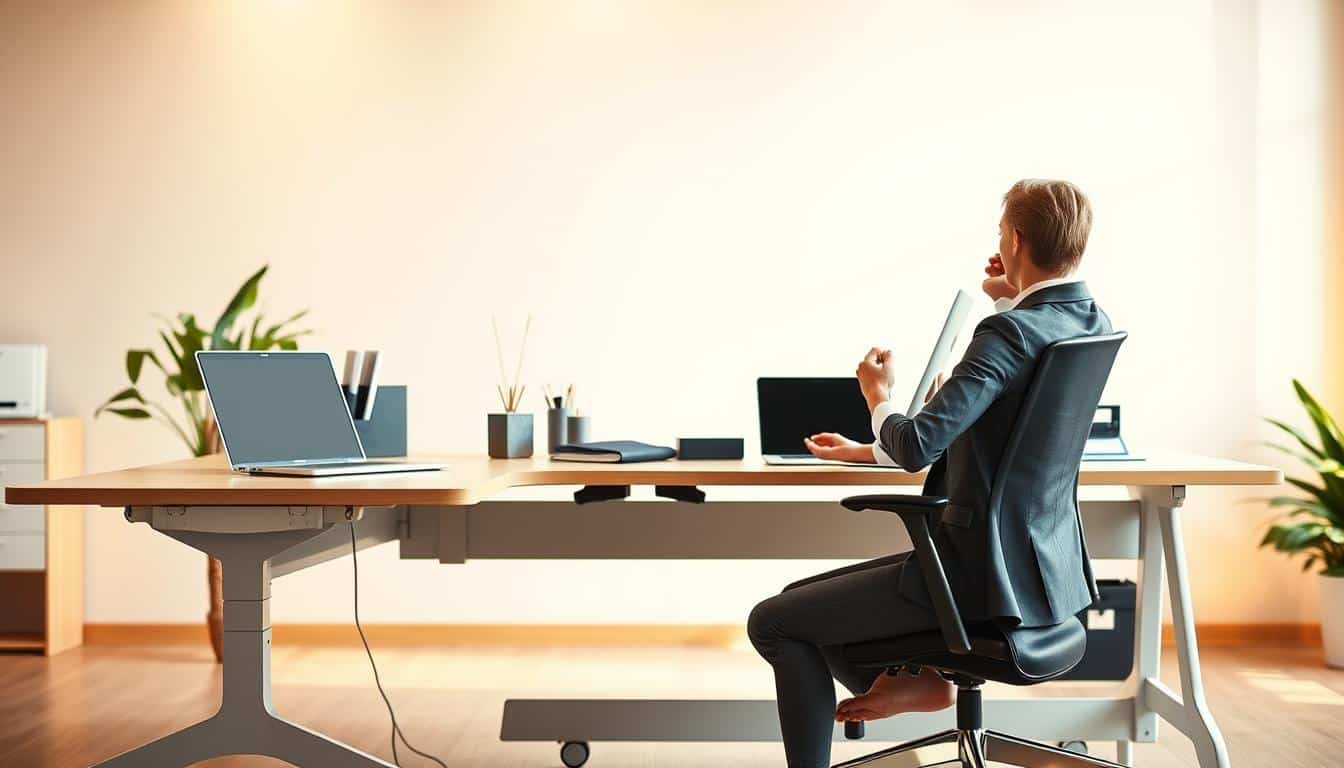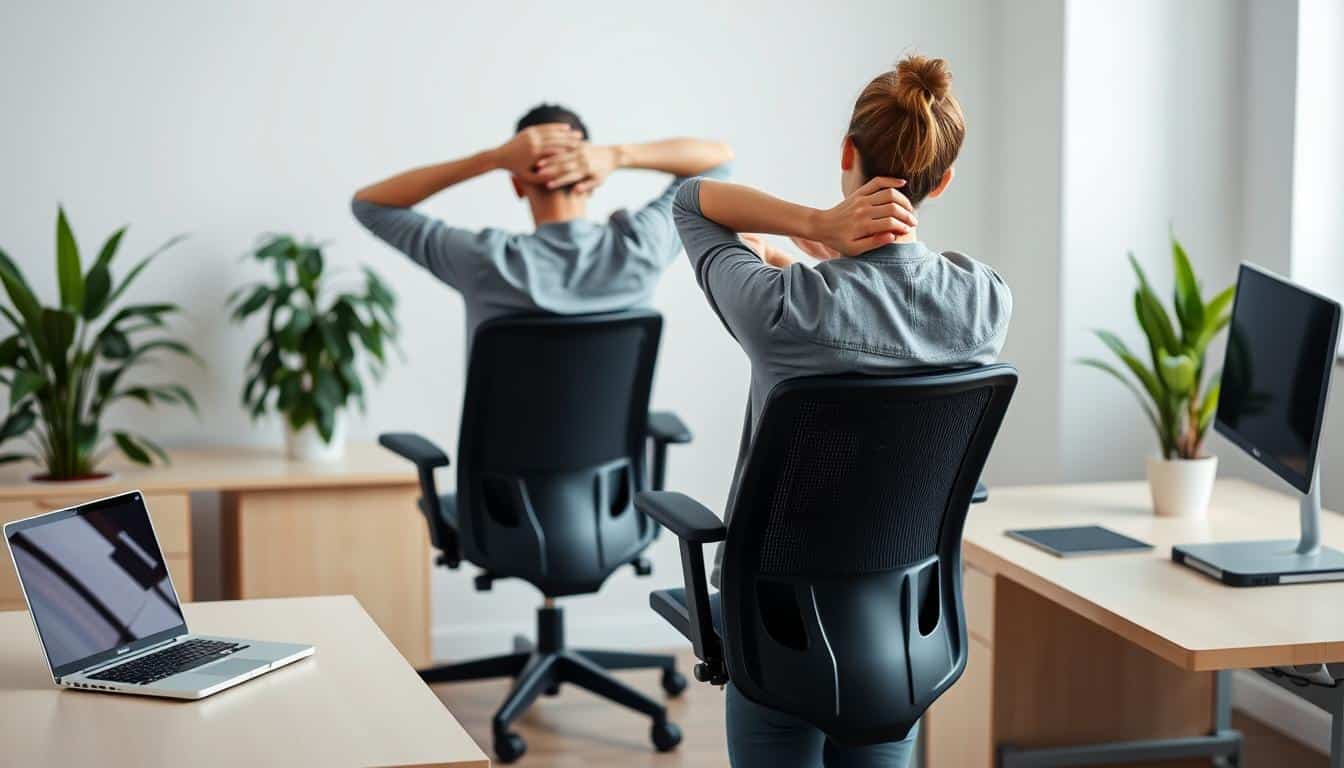In today’s office setting, many people sit for long hours. It’s important to move during the day for health and focus. An effective stretching routine can lessen neck, shoulder, and back pain. By doing simple stretches, you fight bad sitting effects and boost concentration and health.
The U.S. Department of Health and Human Services advises 150-300 minutes of exercise per week. But short office stretch breaks help too. Stretching every 30 minutes fights pain, reduces muscle tiredness, and helps manage stress. Learn how easy exercises improve workplace wellness and energize you at work.
Understanding the Importance of Stretching for Desk Workers
Office jobs often make us sit a lot, which can keep us from moving much. This lack of movement can lead to health problems. Knowing why stretching matters can help keep us well at work. Taking 5 to 10 minutes to stretch every hour can fight the side effects of sitting too long. This easy step can reduce muscle pain and stress, increasing work output.
Stretching is good for desk workers because it makes them more flexible and less stiff. It helps with common issues like back pain, neck strain, and shoulder tightness. By stretching regularly, people can keep their joints working well and avoid the stiffness from sitting all day.
Studies show stretching often can make us feel better, lessen long-term pain, and help us focus better at work. Making a stretching plan that fits your own needs can make your muscles more flexible and align your body right. By making stretching a priority, people who work at desks can create a healthier, more effective workplace.
Health Risks Associated with Prolonged Sitting
Sitting for too long is now a big issue in today’s job world. People with desk jobs face many health problems because of not moving much. It’s important to know how bad prolonged sitting can be. This helps us find ways to deal with it.
Musculoskeletal Disorders
Musculoskeletal disorders are common in those who sit a lot. These problems include back, neck, and shoulder pain. Many office workers suffer from them. Being in one position too long makes these issues worse.
Bad setups, like chairs that don’t support well or desks at the wrong height, cause a lot of this pain. Studies show that more than half of office workers have neck and back pain. This shows we need to move and stretch during the day.
Cardiovascular Health Risks
Heart-related health risks from sitting too much are scary. Research finds that too much sitting increases the risk of getting fat, diabetes, and some cancers. People sitting for over eight hours a day without moving face huge health risks. They are as bad as those from smoking or being very overweight.
Data link sitting a lot to high blood pressure and heart problems. Taking breaks to stand every 30 minutes or using a stand-up desk helps. This can make your heart health better and lower these risks.
Benefits of an Office Stretching Routine
Adding stretching to your daily work routine offers many benefits, especially for those who sit a lot. It improves health, makes you more mobile, and increases work output. These gains come from making sure to stretch regularly at your desk.
Improved Flexibility
Sitting for hours can make muscles tight and limit movement. By doing stretches, like the Forward Fold and Shoulder Stretch, you can become more flexible. This flexibility helps relax and lengthen muscles. It also lowers the chance of getting hurt from doing the same motions over and over or from sitting too much.
Enhanced Focus and Productivity
Taking brief moments to stretch can really help sharpen your focus and make you more productive. Stretching increases blood flow to your brain and muscles. This can boost how well you think. Doing simple stretches, like stretching your feet or hips and knees, can make work less boring. It lowers stress and sharpens your mind. Studies have found that including these movements at work can improve how much gets done. They also make employees happier and create a healthier work atmosphere.
Creating a Regular Stretching Schedule
For those who sit at a desk all day, having a regular stretching schedule is key. It encourages movement and helps ease the stress of sitting too long. Experts recommend taking stretch or walk breaks every 30 to 45 minutes. You can use your phone or apps to remind you to stretch, so you don’t forget these important breaks.
Adding stretching to your day brings big benefits. It makes you more flexible, betters your posture, and eases muscle tightness. You can try simple stretches like head and shoulder circles, or seated leg stretches. These take 15 to 30 seconds each and don’t need any special gear. You can easily fit them into your day.
Sticking to a stretch routine is good for you in the long run. You can sprinkle short stretches into your day to stay flexible. This not just makes you feel better physically but also sharpens your mind and boosts how much you get done.
Essential Office Stretching Routine for Desk Workers
Desk workers often face discomfort from sitting too long. This can cause tightness in the neck and shoulders. A good stretching routine can ease this tension and boost well-being. It’s wise to stretch your neck, shoulders, upper body, and arms every day. This helps with posture and helps you relax. It also tackles muscle tightness from typing and using a mouse.
Neck and Shoulder Stretches
Try these stretches to lessen neck and shoulder tension:
- Neck Rolls: Roll your head slowly in a circle to loosen up.
- Shoulder Shrugs: Lift your shoulders to your ears, then let them drop to feel more relaxed.
- Seated Spinal Twists: Sit and gently twist your torso to one side, then the other, holding each side a bit.
- Neck Tilts: Tilt your head to bring your ear toward your shoulder. This stretches your neck’s side.
Upper Body and Arm Stretches
Don’t forget to stretch your upper body and arms too. It helps with blood flow and eases tension. Here are some to try:
- Triceps Stretch: Lift an arm up, bend the elbow, and lightly pull it with the other hand.
- Lateral Arm Stretch: Reach an arm over your head and lean to stretch your body’s side.
- Chest and Shoulder Opener: Lower one arm, then reach it over your head and lean for a deep stretch.
- Wrist and Forearm Stretch: Stretch one arm out, palm up, and gently pull back the fingers with your other hand.
Incorporating Movement into Your Workday
Adding movement to your workday helps fight fatigue from sitting too long. Taking short breaks every hour is key. These breaks can involve walking or stretching. They improve blood flow, bringing oxygen to your muscles. This helps clear out toxins that make you tired and keeps the workplace healthy.
Micro-Breaks Every Hour
Frequent short breaks throughout your day can prevent back and neck problems. Stretching exercises can make you more flexible and reduce soreness. Doing squats, lunges, or neck stretches boosts brain function. It improves your mood by increasing blood flow and releasing endorphins.
- Set reminders on fitness trackers or timers to take regular micro-breaks.
- Utilize break software to encourage movement during tedious tasks.
- Incorporate exercises such as desk push-ups or chair dips to strengthen muscles.
- Practice good posture throughout the day to support spinal health.
Using a Standing Desk
Standing desks decrease the amount of time you spend sitting. They help you form active work habits and improve your posture. Switching between sitting and standing better your circulation and reduces discomfort. Using a standing desk with micro-breaks multiplies the benefits of staying active at work.
- Adapt your workspace by adding a resistance band for quick strength exercises.
- Stand during phone calls or meetings to break the monotony of sitting.
- Keep an exercise log to track your movement and aim for increased activity weekly.
- Engage with colleagues in shared fitness goals for added motivation.

Tips for Reducing Muscle Tension
Muscle tension relief is key for those sitting at a desk all day. It leads to better health at work. Make sure your workspace supports your posture. Check that your chair and desk encourage you to sit correctly.
Adding tension relief tips like easy stretches during the day helps a lot. Try doing arm stretches, such as pulling your arm across your body. Hold these stretches for a bit, between 10 to 30 seconds, to help your muscles relax.
Stretching your torso helps too, especially after sitting for a while. Stretch your legs and knees to combat discomfort. For your neck and shoulders, do simple exercises like shrugs and tilts. Stick with each movement for around 30 seconds for the best effect.
It’s good to stretch all your major muscles a few times weekly. Begin with a warm-up of 5-10 minutes. Regular stretching cuts down on muscle soreness and can drop pain by up to 72%. This can make a huge difference in how focused and productive you are at work.
Stretching Techniques to Avoid Injury
Safe stretching techniques are key for desk workers who want to be more flexible and avoid getting hurt. Making sure you stretch the right way is crucial. It means doing stretches safely and well. Using gentle movements helps you see better results and keeps you safe.
Proper Form Guidelines
Follow these tips to make your stretching routine work better:
- Always warm up before stretching to prepare your muscles for movement.
- Focus on holding each stretch for 10 to 30 seconds to allow muscles to relax and lengthen.
- Perform stretches smoothly, avoiding any jerky movements that could lead to injury.
- Include deep breathing to promote relaxation and enhance oxygen flow during each stretch.
Recognizing Signs of Discomfort
Listening to your body helps prevent injuries and improve your stretching. Here are tips to recognize when you’re uncomfortable:
- Discomfort is normal during stretching, but sharp pain indicates a need to stop immediately.
- Monitor your body’s responses to specific stretches, noting any areas that feel strained or painful.
- If any stretch exacerbates pain, consult a healthcare professional for guidance.
- Practice stretches that promote good posture and neck relaxation, such as the cable stretch and diagonal neck stretch.
Ergonomic Considerations for Your Workspace
An ergonomic workspace is key for keeping office workers healthy and comfy. It means setting your chair, desk, and monitor right based on your needs. This can stop strains and increase comfort at your desk.
To make your workspace ergonomic, start with your chair. Your feet should be flat on the ground, and your elbows at a 90-degree angle. This helps you sit better and feel less tired. Your desk should let you reach things easily without stretching too much. Your monitor should be at eye level so you don’t strain your eyes or neck.
Stretching a bit, like doing neck tilts and shoulder rolls, helps with tight muscles. Also, taking short breaks every 30 minutes to an hour is good. These simple steps make your work area better and more comfortable.
Conclusion
Making time for office stretching every day is key for people who work at desks. It helps keep your body and mind healthy. Studies show that stretching regularly can make you more flexible, lessen pain, and boost your work performance. For example, one study found that stretching reduced neck and back pain significantly, showing how important it is to stay active at work.
People who stretch twice a day felt better and improved their lives more than those who just got ergonomic tips. This shows stretching does more than ease pain right away. It aids in fighting the bad effects of sitting too much over time.
By sticking with a stretching plan, you can change how you feel at work every day. Learning the right way to stretch and taking short breaks to do it helps fight off the harm from sitting all day. This reminder to stretch at work stresses that looking after our health and happiness at work is crucial.



